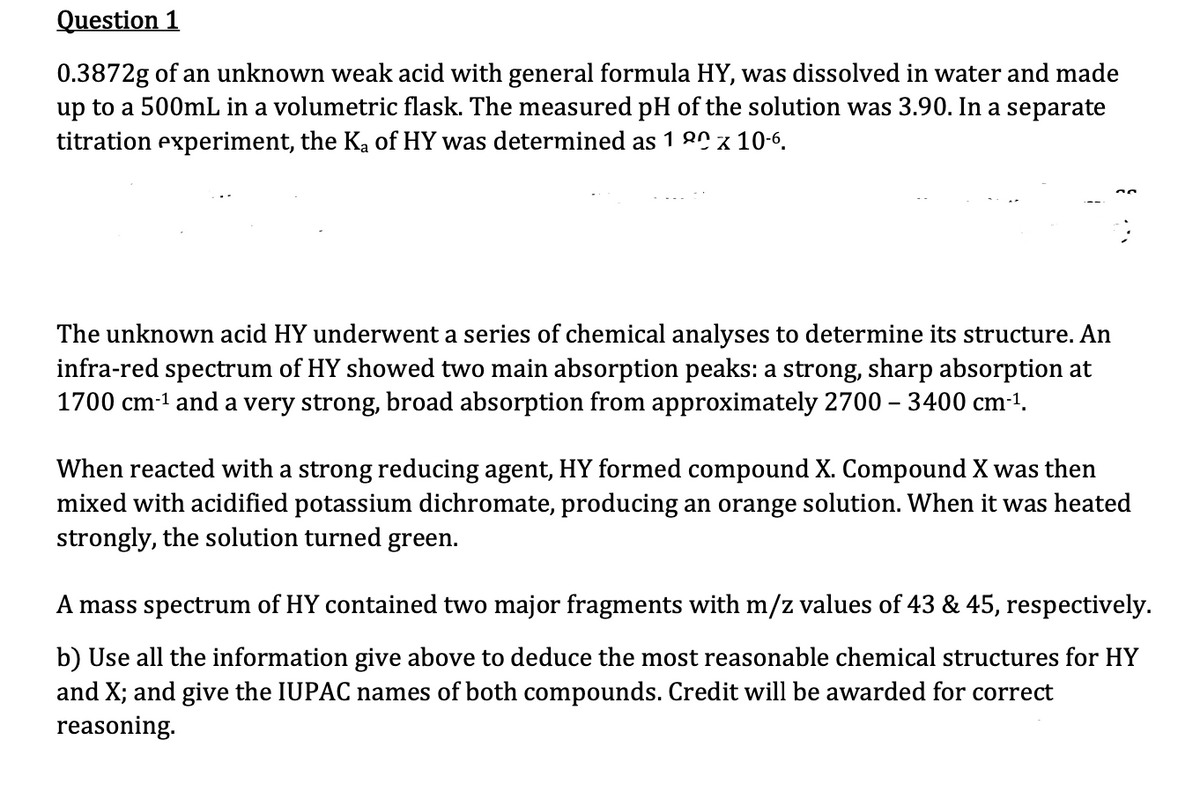0.3872g of an unknown weak acid with general formula HY, was dissolved in water and made up to a 500mL in a volumetric flask. The measured pH of the solution was 3.90. In a separate titration experiment, the K₂ of HY was determined as 100 x 10-6. The unknown acid HY underwent a series of chemical analyses to determine its structure. An infra-red spectrum of HY showed two main absorption peaks: a strong, sharp absorption at 1700 cm-¹ and a very strong, broad absorption from approximately 2700 - 3400 cm-¹. When reacted with a strong reducing agent, HY formed compound X. Compound X was then mixed with acidified potassium dichromate, producing an orange solution. When it was heated strongly, the solution turned green. A mass spectrum of HY contained two major fragments with m/z values of 43 & 45, respectively. b) Use all the information give above to deduce the most reasonable chemical structures for HY and X; and give the IUPAC names of both compounds. Credit will be awarded for correct reasoning.
0.3872g of an unknown weak acid with general formula HY, was dissolved in water and made up to a 500mL in a volumetric flask. The measured pH of the solution was 3.90. In a separate titration experiment, the K₂ of HY was determined as 100 x 10-6. The unknown acid HY underwent a series of chemical analyses to determine its structure. An infra-red spectrum of HY showed two main absorption peaks: a strong, sharp absorption at 1700 cm-¹ and a very strong, broad absorption from approximately 2700 - 3400 cm-¹. When reacted with a strong reducing agent, HY formed compound X. Compound X was then mixed with acidified potassium dichromate, producing an orange solution. When it was heated strongly, the solution turned green. A mass spectrum of HY contained two major fragments with m/z values of 43 & 45, respectively. b) Use all the information give above to deduce the most reasonable chemical structures for HY and X; and give the IUPAC names of both compounds. Credit will be awarded for correct reasoning.
Chemistry & Chemical Reactivity
9th Edition
ISBN:9781133949640
Author:John C. Kotz, Paul M. Treichel, John Townsend, David Treichel
Publisher:John C. Kotz, Paul M. Treichel, John Townsend, David Treichel
Chapter16: Principles Of Chemical Reactivity: The Chemistry Of Acids And Bases
Section: Chapter Questions
Problem 110IL
Related questions
Question

Transcribed Image Text:Question 1
0.3872g of an unknown weak acid with general formula HY, was dissolved in water and made
up to a 500mL in a volumetric flask. The measured pH of the solution was 3.90. In a separate
titration experiment, the K₂ of HY was determined as 100 x 10-6.
The unknown acid HY underwent a series of chemical analyses to determine its structure. An
infra-red spectrum of HY showed two main absorption peaks: a strong, sharp absorption at
1700 cm-¹ and a very strong, broad absorption from approximately 2700 - 3400 cm-¹.
When reacted with a strong reducing agent, HY formed compound X. Compound X was then
mixed with acidified potassium dichromate, producing an orange solution. When it was heated
strongly, the solution turned green.
A mass spectrum of HY contained two major fragments with m/z values of 43 & 45, respectively.
b) Use all the information give above to deduce the most reasonable chemical structures for HY
and X; and give the IUPAC names of both compounds. Credit will be awarded for correct
reasoning.
Expert Solution
This question has been solved!
Explore an expertly crafted, step-by-step solution for a thorough understanding of key concepts.
Step by step
Solved in 4 steps

Knowledge Booster
Learn more about
Need a deep-dive on the concept behind this application? Look no further. Learn more about this topic, chemistry and related others by exploring similar questions and additional content below.Recommended textbooks for you

Chemistry & Chemical Reactivity
Chemistry
ISBN:
9781133949640
Author:
John C. Kotz, Paul M. Treichel, John Townsend, David Treichel
Publisher:
Cengage Learning

Chemistry & Chemical Reactivity
Chemistry
ISBN:
9781337399074
Author:
John C. Kotz, Paul M. Treichel, John Townsend, David Treichel
Publisher:
Cengage Learning


Chemistry & Chemical Reactivity
Chemistry
ISBN:
9781133949640
Author:
John C. Kotz, Paul M. Treichel, John Townsend, David Treichel
Publisher:
Cengage Learning

Chemistry & Chemical Reactivity
Chemistry
ISBN:
9781337399074
Author:
John C. Kotz, Paul M. Treichel, John Townsend, David Treichel
Publisher:
Cengage Learning
